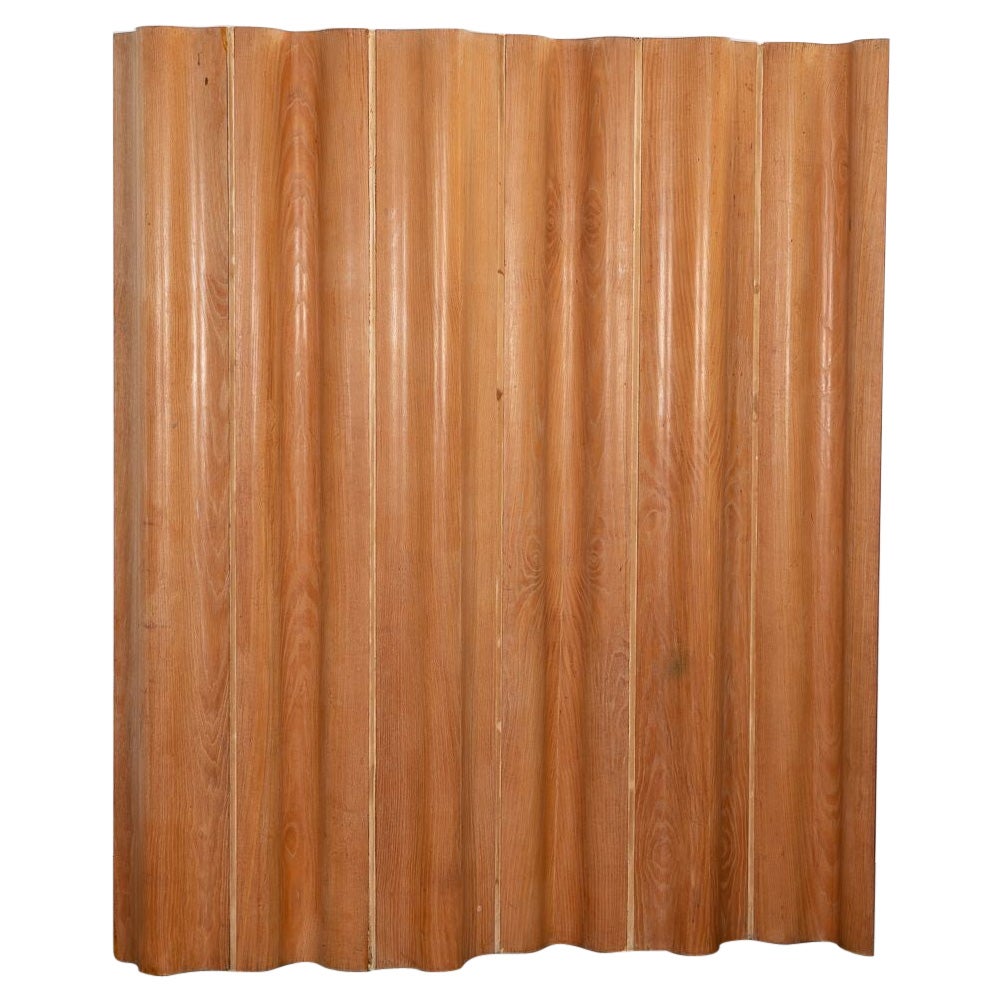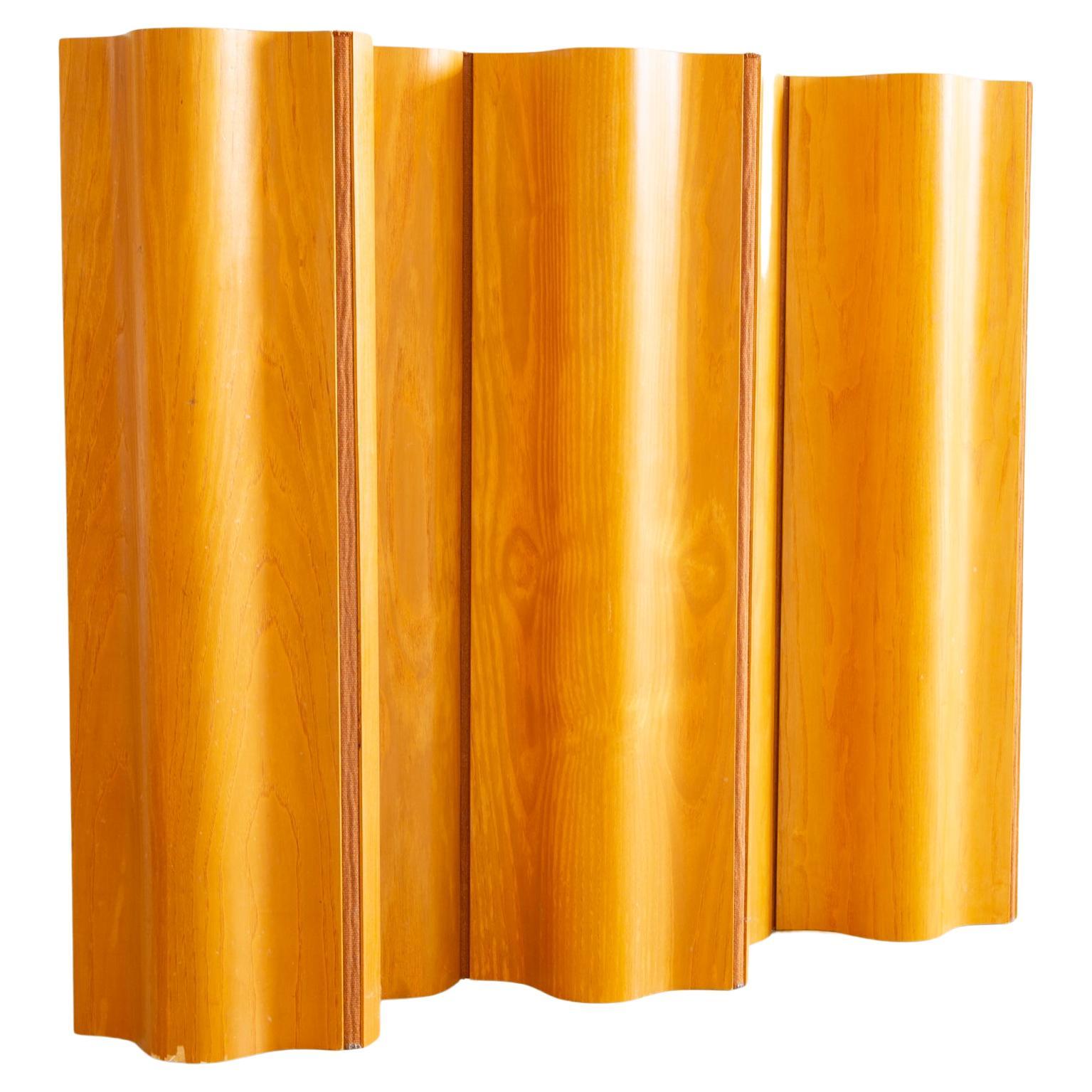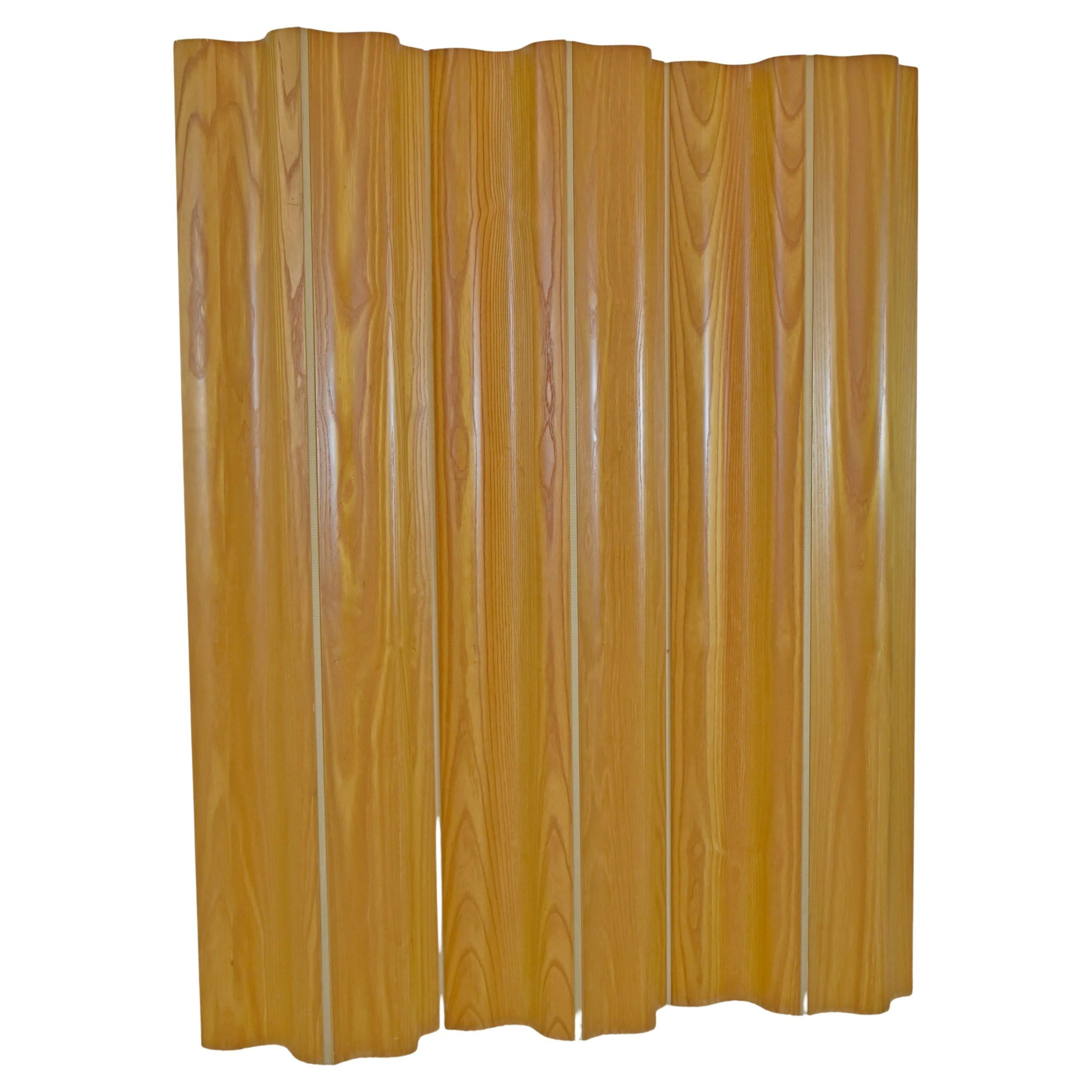Charles and Ray Eames for Herman Miller Plywood Folding Screen Ash Veneer 1950s
About the Item
- Creator:Charles and Ray Eames (Designer),Herman Miller (Manufacturer)
- Design:
- Dimensions:Height: 68 in (172.72 cm)Width: 60 in (152.4 cm)Depth: 5 in (12.7 cm)
- Style:Mid-Century Modern (Of the Period)
- Materials and Techniques:
- Place of Origin:
- Period:
- Date of Manufacture:circa 1950s
- Condition:Wear consistent with age and use. Minor losses. Minor structural damages. Minor fading. Canvas hinge has some fraying at edges and light staining. One hinge is slightly loose within the wooden groove but still is secure and functions. Light scratches and wear commensurate with age and normal use and light water stains near the bottom.
- Seller Location:Cathedral City, CA
- Reference Number:
Charles and Ray Eames
Charles Eames and Ray Eames were the embodiment of the inventiveness, energy and optimism at the heart of mid-century modern American design, and have been recognized as the most influential designers of the 20th century.
As furniture designers, filmmakers, artists, textile and graphic designers and even toy and puzzle makers, the Eameses were a visionary and effective force for the notion that design should be an agent of positive change. They are the happy, ever-curious, ever-adventurous faces of modernism.
Charles (1907–78) studied architecture and industrial design. Ray (née Beatrice Alexandra Kaiser, 1912–88) was an artist, who studied under the Abstract Expressionist painter Hans Hofmann. They met in 1940 at the Cranbrook Academy of Art in suburban Detroit (the legendary institution where Charles also met his frequent collaborator Eero Saarinen and the artist and designer Harry Bertoia) and married the next year.
His technical skills and her artistic flair were wonderfully complementary. They moved to Los Angeles in 1941, where Charles worked on set design for MGM. In the evenings at their apartment, they experimented with molded plywood using a handmade heat-and-pressurization device they called the “Kazam!” machine. The next year, they won a contract from the U.S. Navy for lightweight plywood leg splints for wounded servicemen — they are coveted collectibles today; more so those that Ray used to make sculptures.
The Navy contract allowed Charles to open a professional studio, and the attention-grabbing plywood furniture the firm produced prompted George Nelson, the director of design of the furniture-maker Herman Miller Inc., to enlist Charles and (by association, if not by contract) Ray in 1946. Some of the first Eames items to emerge from Herman Miller are now classics: the LCW, or Lounge Chair Wood, and the DCM, or Dining Chair Metal, supported by tubular steel.
The Eameses eagerly embraced new technology and materials, and one of their peculiar talents was to imbue their supremely modern design with references to folk traditions. Their Wire chair group of the 1950s, for example, was inspired by basket weaving techniques. The populist notion of “good design for all” drove their molded fiberglass chair series that same decade, and also produced the organic-form, ever-delightful La Chaise. In 1956 the Eames lounge chair and ottoman appeared — the supremely comfortable plywood-base-and-leather-upholstery creation that will likely live in homes as long as there are people with good taste and sense.
Charles Eames once said, “The role of the designer is that of a very good, thoughtful host anticipating the needs of his guests.” For very good collectors and thoughtful interior designers, a piece of design by the Eameses, the closer produced to original conception the better, is almost de rigueur — for its beauty and comfort, and not least as a tribute to the creative legacy and enduring influence of Charles and Ray Eames.
The collection of original Eames furniture on 1stDibs includes chairs, tables, case pieces and other items.
Herman Miller
No other business of its kind did more than the Herman Miller Furniture Company to introduce modern design into American homes. Working with legendary designers such as Charles and Ray Eames, George Nelson and Alexander Girard, the Zeeland, Michigan-based firm fostered some of the boldest expressions of what we now call mid-century modern style. In doing so, Herman Miller produced some of the most beautiful, iconic and, one can even say, noblest furniture ever.
Founded in 1923, Herman Miller was originally known for grand historicist bedroom suites: heavily ornamented wood furniture that appealed to a high-minded, wealthier clientele. The company — named for its chief financial backer — began to suffer in the early 1930s as the Great Depression hit, and D.J. De Pree, the company’s CEO, feared bankruptcy. In 1932, aid came in the form of Gilbert Rohde, a self-taught furniture designer who had traveled widely in Europe, absorbing details of the Art Deco movement and other modernist influences. After persuading De Pree that the growing middle-class required smaller, lighter household furnishings, Rohde set a new course for Herman Miller, creating sleek chairs, tables and cabinetry that were the essence of the Streamline Moderne style.
Rohde died suddenly in 1944. The following year, De Pree turned to George Nelson, an architect who had written widely about modern furniture design. Under Nelson’s leadership, Herman Miller would embrace new technologies and materials and audacious biomorphic forms. Some of the pieces the company produced are now emblems of 20th century American design, including the Eames lounge chair and ottoman and Nelson’s Marshmallow sofa and Coconut chair. As you can see on 1stDibs, such instantly recognizable furnishings have become timeless — staples of a modernist décor; striking, offbeat notes in traditional environments.
- ShippingRetrieving quote...Ships From: Cathedral City, CA
- Return PolicyA return for this item may be initiated within 3 days of delivery.
- Marc Bellaire California Ceramic Native Head Wall Sculpture, Ca 1950sBy Marc BellaireLocated in Cathedral City, CARare Marc Bellaire ceramic head sculpture in the Polynesian style akin to the stone "Moai" sculptures found on Easter Island. In the many years I have collected Marc Bellaire, this is the first time seeing this piece. It likely belongs to one of his Island-themed lines. Measure 12" high x 6" wide x 5-1/2" deep. Hole at back of sculpture allows hanging on the wall or can place on a surface as shown for use as a tabletop sculpture. Marc Bellaire was born in 1925 in Toledo, Ohio. He studied at the Toledo Museum of Art while employed at the Libby Glass...Category
Vintage 1950s American Mid-Century Modern Wall-mounted Sculptures
MaterialsCeramic
- Danny Ho Fong for Tropi-Cal Wicker and Iron Dining Table and Chairs, ca 1960sBy Tropi-cal, Danny Ho FongLocated in Cathedral City, CADanny Ho Fong for Tropi-Cal Wicker and Iron Dining Table and Chairs, ca 1960s. Sublime Asian-inspired California Design wicker and iron dining set by Danny Ho Fong for Tropical-Cal ...Category
Mid-20th Century American Mid-Century Modern Dining Room Tables
MaterialsIron
- Pair Rodney Kinsman Red T7 Tractor Stools for OMK, 1971By Rodney Kinsman, OMKLocated in Cathedral City, CAA pair of fabulous T7 Tractor seat stools designed by Rodney Kinsman, a British designer, for his company OMK in 1971. Truly an avant-garde design in a highly desirable red color. Th...Category
Vintage 1970s English Post-Modern Stools
MaterialsEnamel, Steel, Chrome
- Sally Sirken Lewis for J. Robert Scott Goatskin Game Table, ca 1980sBy Sally Sirkin Lewis, J. Robert Scott 1Located in Cathedral City, CASally Sirken Lewis for J. Robert Scott Goatskin Game Table, circa 1980s. A beautiful and Classic design. Measurements - Overall: 29 ½" high x 36" wide x 36" deep, Chair Opening: 2...Category
Vintage 1980s American Hollywood Regency Card Tables and Tea Tables
MaterialsGoatskin, Wood, Lacquer
- Karim Rashid Silver Vinyl Shroom Stool for IDEE Limited Edition Signed NumberedBy Karim Rashid, Idée JapanLocated in Cathedral City, CAKarim Rashid Shroom Stool designed for IDEE, Japan in 1998. This silver vinyl version was a limited edition and is signed and numbered #4/57 on the IDEE labeled fabric on the bottom of the stool. It was part of the TOTEM Design collection; TOTEM - The Objects That Evoke Meaning - was a a progressive and influential retail design gallery in Manhattan operating between 1994-2004 that represented cutting edge modern design of the period. Overall the stool is on good condition with a couple small tears, minor dents and scuffs to the vinyl, and wear as shown in the detail photos. The stool measures 18" high x 16 ½" wide x 14" deep. Karim Rashid (born 1960) is an Egyptian-born and Canadian raised industrial designer. His designs include luxury goods, furniture, lighting, surface design, brand identity and packaging. Time magazine has described him as the "most famous industrial designer in all the Americas" and the "Prince of Plastic". He is based in New York City, as well as Belgrade, Miami and India. Rashid's work is featured in 20 permanent collections. His pieces are exhibited in museums worldwide, including the MoMA, Centre Pompidou, and SFMOMA. He is known for designs such as the "Garbo" waste can and "Oh Chair...Category
1990s Japanese Futurist Stools
MaterialsUpholstery, Synthetic, Foam, PVC
- Cuir d'Ocean France Bespoke Shagreen Watch and Cufflink Box w Bone Trim and KeyBy Bergdorf GoodmanLocated in Cathedral City, CAThis is an exquisite shagreen with bone trim watch and cufflink box of the finest quality and construction made by famed bespoke manufacturer of luxury objects, Cuir d'Ocean of Franc...Category
Late 20th Century French Modern Jewelry Boxes
MaterialsBrass
- Original 1950s Eames for Herman Miller FSW-6 Folding Screen Room DividerBy Herman Miller, Charles and Ray EamesLocated in Brooklyn, NYAn early molded plywood screen divider in calico ash, designed by Charles & Ray Eames, manufactured by Herman Miller. The screen's ingenious design allows it to be formed into a vari...Category
Vintage 1950s American Mid-Century Modern Screens and Room Dividers
MaterialsAsh
- Charles and Ray Eames FSW 8 Panel ScreenBy Charles and Ray EamesLocated in West Palm Beach, FLA Birch Plywood and canvas screen Early production Original finish.Category
Vintage 1940s American Screens and Room Dividers
MaterialsBirch
- Half-Size FSW-6 Screen by Charles and Ray EamesBy Charles and Ray EamesLocated in New York, NYHalf-size FSW-6 screen in ash plywood and canvas. Designed by Charles and Ray Eames and manufactured by Herman Miller, Zeeland, MI, circa 1948. Unmarked.Category
Mid-20th Century German Modern Screens and Room Dividers
MaterialsCanvas, Plywood
- Eames 6 Panel Oak Room Divider by Herman MillerBy Herman Miller, Charles and Ray EamesLocated in Toledo, OHEames 6 panel oak room divider by Herman Miller. Designed by Charles and Ray Eames and Manufactured by Herman Miller in the 1940's. A durable woven polypropylene mesh connects the 6 ...Category
Mid-20th Century Screens and Room Dividers
MaterialsOak, Bentwood
- Relay Screen by Kathy Stanton for Herman MillerBy Herman MillerLocated in Chicago, ILc. 1980s. Corrugated orange plastic with black plastic trim. Made by Herman Miller in Michigan.Category
Vintage 1980s American Mid-Century Modern Screens and Room Dividers
MaterialsPlastic
- 1950s Three-Panel Folding ScreenLocated in Philadelphia, PAVienna Werkstatte style screen, circa 1950, in gold and silver leaf with red lacquer background and multi-colored decoration. Double-sided with diffe...Category
Vintage 1950s Austrian Vienna Secession Screens and Room Dividers
MaterialsGold Leaf, Silver Leaf
Recently Viewed
View AllRead More
The 21 Most Popular Mid-Century Modern Chairs
You know the designs, now get the stories about how they came to be.
A Guide to Herman Miller’s Most Iconic Furniture
The prolific manufacturer has partnered with many of the world’s top designers since opening its doors in 1923. Here are some of the company’s greatest hits, which helped transform the American home and office.







